2013 Peugeot 308 SW BL check engine
[x] Cancel search: check enginePage 175 of 382
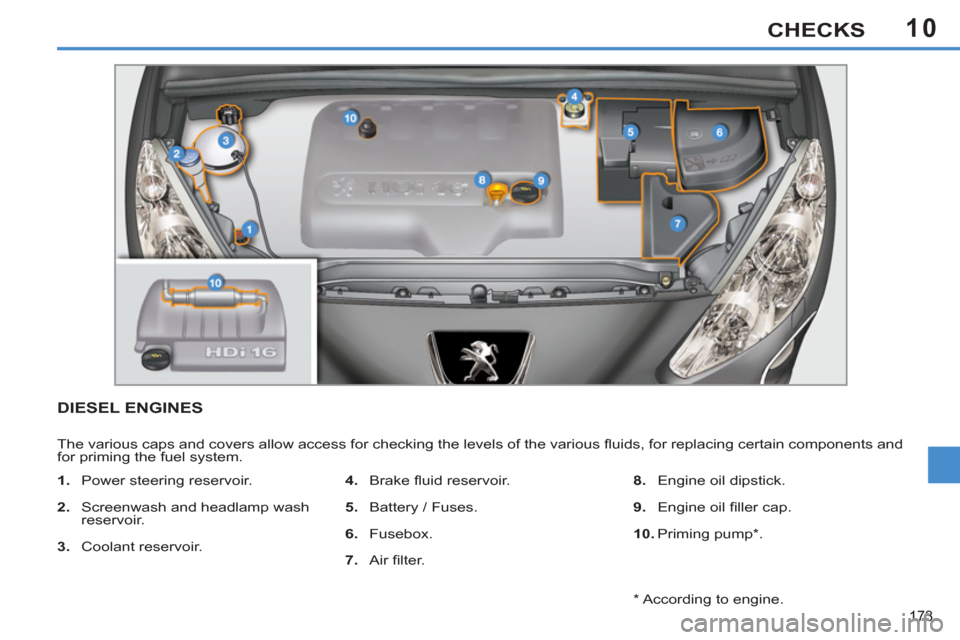
10
173
CHECKS
DIESEL ENGINES
The various caps and covers allow access for checking the levels of the various fl uids, for replacing certain components and
for priming the fuel system.
1.
Power steering reservoir.
2.
Screenwash and headlamp wash
reservoir.
3.
Coolant reservoir.
4.
Brake fl uid reservoir.
5.
Battery / Fuses.
6.
Fusebox.
7.
Air fi lter.
8.
Engine oil dipstick.
9.
Engine oil fi ller cap.
10.
Priming pump * .
*
According to engine.
Page 176 of 382
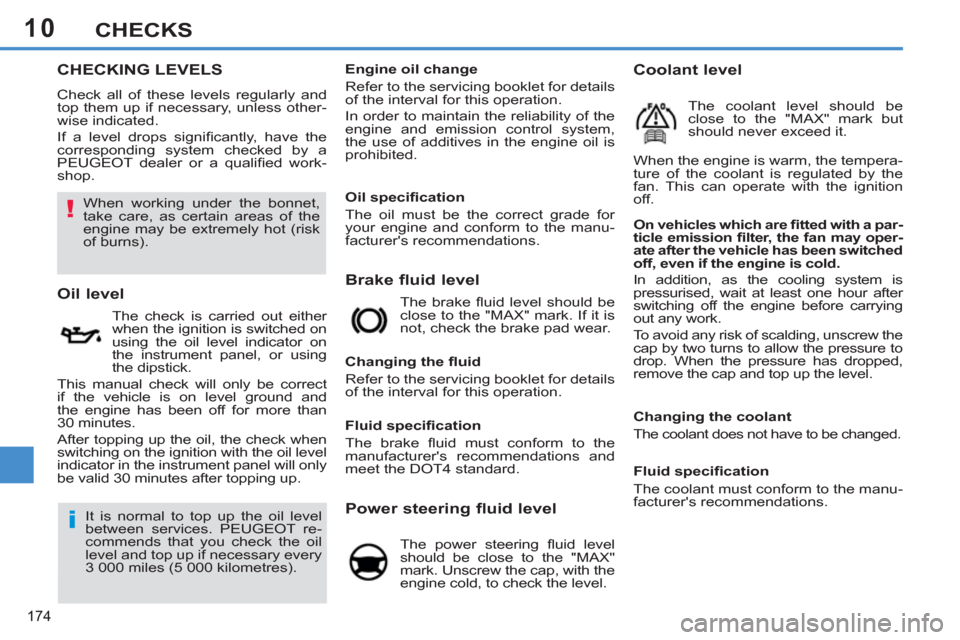
10
174
CHECKS
CHECKING LEVELS
Check all of these levels regularly and
top them up if necessary, unless other-
wise indicated.
If a level drops signifi cantly, have the
corresponding system checked by a
PEUGEOT dealer or a qualifi ed work-
shop.
Brake fluid level
On vehicles which are fi tted with a par-
ticle emission fi lter, the fan may oper-
ate after the vehicle has been switched
off, even if the engine is cold.
In addition, as the cooling system is
pressurised, wait at least one hour after
switching off the engine before carrying
out any work.
To avoid any risk of scalding, unscrew the
cap by two turns to allow the pressure to
drop. When the pressure has dropped,
remove the cap and top up the level.
Oil level
The check is carried out either
when the ignition is switched on
using the oil level indicator on
the instrument panel, or using
the dipstick.
This manual check will only be correct
if the vehicle is on level ground and
the engine has been off for more than
30 minutes.
After topping up the oil, the check when
switching on the ignition with the oil level
indicator in the instrument panel will only
be valid 30 minutes after topping up. The brake fl uid level should be
close to the "MAX" mark. If it is
not, check the brake pad wear.
Changing the fl uid
Refer to the servicing booklet for details
of the interval for this operation.
Power steering fluid level
The power steering fl uid level
should be close to the "MAX"
mark. Unscrew the cap, with the
engine cold, to check the level.
Engine oil change
Refer to the servicing booklet for details
of the interval for this operation.
In order to maintain the reliability of the
engine and emission control system,
the use of additives in the engine oil is
prohibited.
It is normal to top up the oil level
between services. PEUGEOT re-
commends that you check the oil
level and top up if necessary every
3 000 miles (5 000 kilometres).
Fluid specifi cation
The brake fl uid must conform to the
manufacturer's recommendations and
meet the DOT4 standard.
Changing the coolant
The coolant does not have to be changed.
Coolant level
The coolant level should be
close to the "MAX" mark but
should never exceed it.
When the engine is warm, the tempera-
ture of the coolant is regulated by the
fan. This can operate with the ignition
off.
Fluid specifi cation
The coolant must conform to the manu-
facturer's recommendations.
When working under the bonnet,
take care, as certain areas of the
engine may be extremely hot (risk
of burns).
Oil specifi cation
The oil must be the correct grade for
your engine and conform to the manu-
facturer's recommendations.
Page 178 of 382
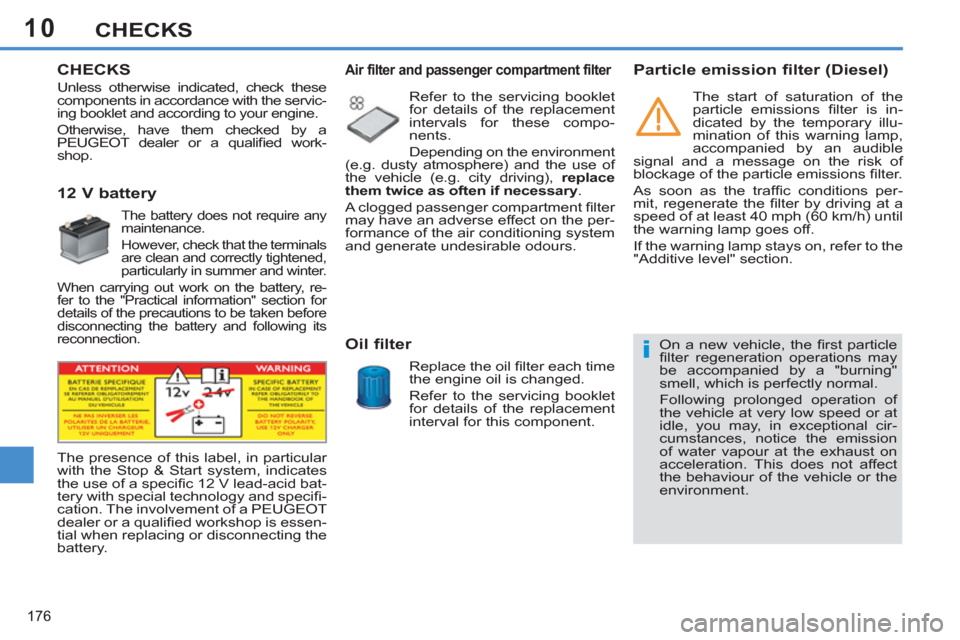
10
176
CHECKS
CHECKS
12 V battery
The battery does not require any
maintenance.
However, check that the terminals
are clean and correctly tightened,
particularly in summer and winter.
When carrying out work on the battery, re-
fer to the "Practical information" section for
details of the precautions to be taken before
disconnecting the battery and following its
reconnection.
The presence of this label, in particular
with the Stop & Start system, indicates
the use of a specifi c 12 V lead-acid bat-
tery with special technology and specifi -
cation. The involvement of a PEUGEOT
dealer or a qualifi ed workshop is essen-
tial when replacing or disconnecting the
battery.
Particle emission filter (Diesel)
The start of saturation of the
particle emissions fi lter is in-
dicated by the temporary illu-
mination of this warning lamp,
accompanied by an audible
signal and a message on the risk of
blockage of the particle emissions fi lter.
As soon as the traffi c conditions per-
mit, regenerate the fi lter by driving at a
speed of at least 40 mph (60 km/h) until
the warning lamp goes off.
If the warning lamp stays on, refer to the
"Additive level" section.
On a new vehicle, the fi rst particle
fi lter regeneration operations may
be accompanied by a "burning"
smell, which is perfectly normal.
Following prolonged operation of
the vehicle at very low speed or at
idle, you may, in exceptional cir-
cumstances, notice the emission
of water vapour at the exhaust on
acceleration. This does not affect
the behaviour of the vehicle or the
environment.
Unless otherwise indicated, check these
components in accordance with the servic-
ing booklet and according to your engine.
Otherwise, have them checked by a
PEUGEOT dealer or a qualifi ed work-
shop.
Air filter and passenger compartment filter
Refer to the servicing booklet
for details of the replacement
intervals for these compo-
nents.
Depending on the environment
(e.g. dusty atmosphere) and the use of
the vehicle (e.g. city driving), replace
them twice as often if necessary
.
A clogged passenger compartment fi lter
may have an adverse effect on the per-
formance of the air conditioning system
and generate undesirable odours.
Oil filter
Replace the oil fi lter each time
the engine oil is changed.
Refer to the servicing booklet
for details of the replacement
interval for this component.
Page 179 of 382
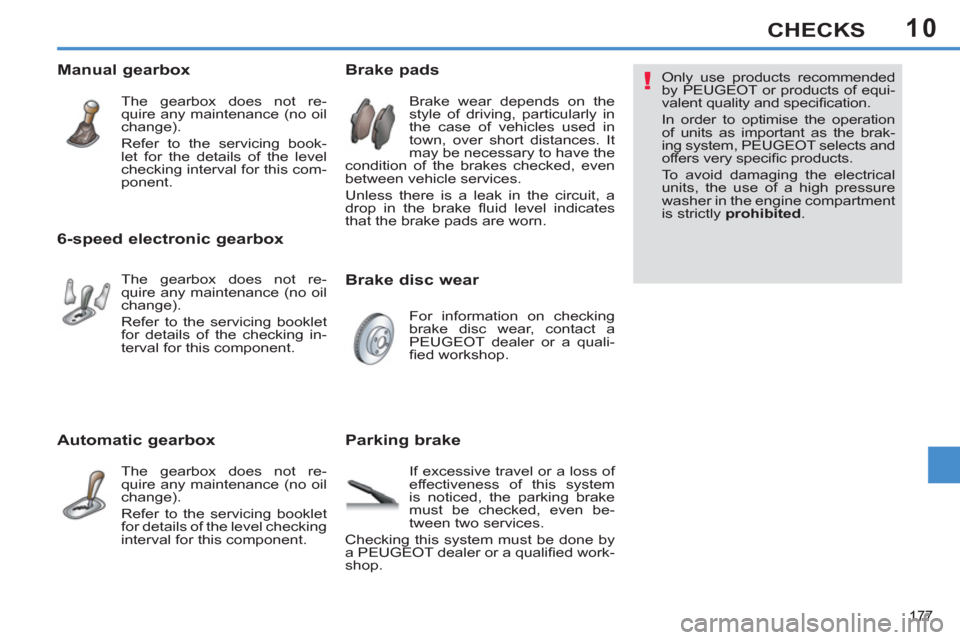
10
177
CHECKS
Brake disc wear
Brake pads
Brake wear depends on the
style of driving, particularly in
the case of vehicles used in
town, over short distances. It
may be necessary to have the
condition of the brakes checked, even
between vehicle services.
Unless there is a leak in the circuit, a
drop in the brake fl uid level indicates
that the brake pads are worn.
For information on checking
brake disc wear, contact a
PEUGEOT dealer or a quali-
fi ed workshop.
Manual gearbox
The gearbox does not re-
quire any maintenance (no oil
change).
Refer to the servicing book-
let for the details of the level
checking interval for this com-
ponent.
6-speed electronic gearbox
The gearbox does not re-
quire any maintenance (no oil
change).
Refer to the servicing booklet
for details of the checking in-
terval for this component.
Automatic gearbox
The gearbox does not re-
quire any maintenance (no oil
change).
Refer to the servicing booklet
for details of the level checking
interval for this component.
Only use products recommended
by PEUGEOT or products of equi-
valent quality and specifi cation.
In order to optimise the operation
of units as important as the brak-
ing system, PEUGEOT selects and
offers very specifi c products.
To avoid damaging the electrical
units, the use of a high pressure
washer in the engine compartment
is strictly prohibited
.
Parking brake
If excessive travel or a loss of
effectiveness of this system
is noticed, the parking brake
must be checked, even be-
tween two services.
Checking this system must be done by
a PEUGEOT dealer or a qualifi ed work-
shop.
Page 185 of 382
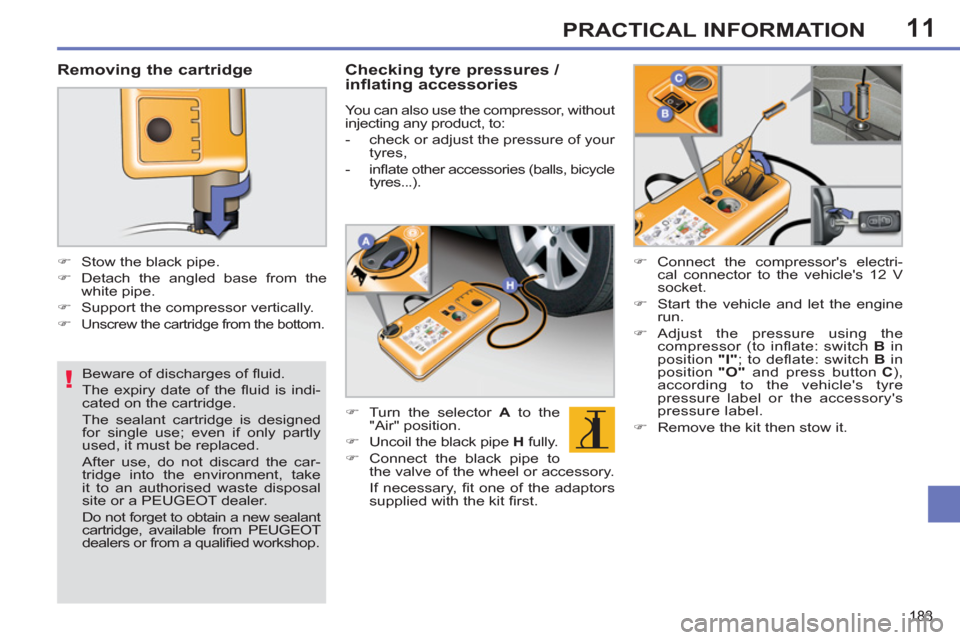
11
!
183
PRACTICAL INFORMATION
Beware of discharges of fl uid.
The expiry date of the fl uid is indi-
cated on the cartridge.
The sealant cartridge is designed
for single use; even if only partly
used, it must be replaced.
After use, do not discard the car-
tridge into the environment, take
it to an authorised waste disposal
site or a PEUGEOT dealer.
Do not forget to obtain a new sealant
cartridge, available from PEUGEOT
dealers or from a qualifi ed workshop.
Removing the cartridge
�)
Stow the black pipe.
�)
Detach the angled base from the
white pipe.
�)
Support the compressor vertically.
�)
Unscrew the cartridge from the bottom.
Checking tyre pressures /
inflating accessories
You can also use the compressor, without
injecting any product, to:
- check or adjust the pressure of your
tyres,
- infl ate other accessories (balls, bicycle
tyres...).
�)
Turn the selector A
to the
"Air" position.
�)
Uncoil the black pipe H
fully.
�)
Connect the black pipe to
the valve of the wheel or accessory.
If necessary, fi t one of the adaptors
supplied with the kit fi rst.
�)
Connect the compressor's electri-
cal connector to the vehicle's 12 V
socket.
�)
Start the vehicle and let the engine
run.
�)
Adjust the pressure using the
compressor (to infl ate: switch B
in
position "I"
; to defl ate: switch B
in
position "O"
and press button C
),
according to the vehicle's tyre
pressure label or the accessory's
pressure label.
�)
Remove the kit then stow it.
Page 186 of 382

11
184
PRACTICAL INFORMATION
It is designed to repair holes of a
maximum diameter of 6 mm, only
where located on the tyre tread or
shoulder. Avoid removing any for-
eign bodies which have penetrated
the tyre.
TEMPORARY PUNCTURE REPAIR KIT
Complete system consisting of a com-
pressor and a bottle of sealant which per-
mits temporary repair
of the tyre so that
you can drive to the nearest garage.
The kit is stowed in the boot storage
tray.
Using the kit
�)
Switch off the ignition.
�)
Tick the wheel to be repaired on the
speed limitation sticker enclosed
then affi x the sticker to the vehicle's
steering wheel to remind you that a
wheel is in temporary use.
�)
Clip the bottle 1
on the compressor 2
.
�)
Check that the switch A
is tilted to
position "0"
.
�)
Connect the pipe of the bottle 1
to
the valve of the tyre to be repaired.
�)
Unwind the pipe of the compressor 2
fully, then connect it to the bottle.
�)
Connect the compressor's electric
plug to the vehicle's 12 V socket.
�)
Start the vehicle and leave the engine
running.
Page 188 of 382
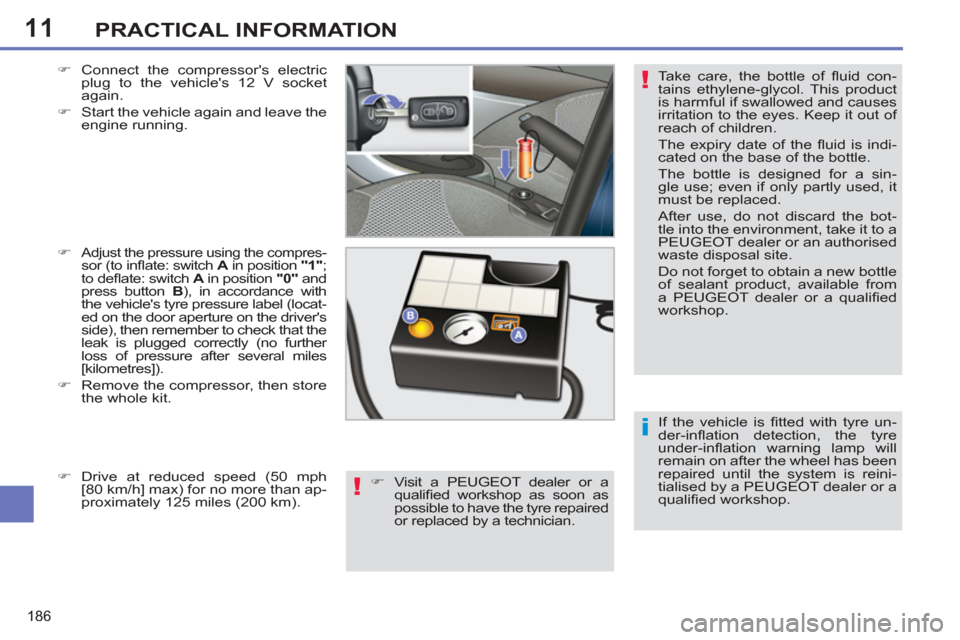
11
186
PRACTICAL INFORMATION
If the vehicle is fi tted with tyre un-
der-infl ation detection, the tyre
under-infl ation warning lamp will
remain on after the wheel has been
repaired until the system is reini-
tialised by a PEUGEOT dealer or a
qualifi ed workshop. Take care, the bottle of fl uid con-
tains ethylene-glycol. This product
is harmful if swallowed and causes
irritation to the eyes. Keep it out of
reach of children.
The expiry date of the fl uid is indi-
cated on the base of the bottle.
The bottle is designed for a sin-
gle use; even if only partly used, it
must be replaced.
After use, do not discard the bot-
tle into the environment, take it to a
PEUGEOT dealer or an authorised
waste disposal site.
Do not forget to obtain a new bottle
of sealant product, available from
a PEUGEOT dealer or a qualifi ed
workshop.
�)
Connect the compressor's electric
plug to the vehicle's 12 V socket
again.
�)
Start the vehicle again and leave the
engine running.
�)
Adjust the pressure using the compres-sor (to infl ate: switch A
in position "1"
;
to defl ate: switch A
in position "0"
and
press button B
), in accordance with
the vehicle's tyre pressure label (locat-
ed on the door aperture on the driver's
side), then remember to check that the
leak is plugged correctly (no further
loss of pressure after several miles
[kilometres]).
�)
Remove the compressor, then store
the whole kit.
�)
Visit a PEUGEOT dealer or a
qualifi ed workshop as soon as
possible to have the tyre repaired
or replaced by a technician.
�)
Drive at reduced speed (50 mph
[80 km/h] max) for no more than ap-
proximately 125 miles (200 km).
Page 209 of 382
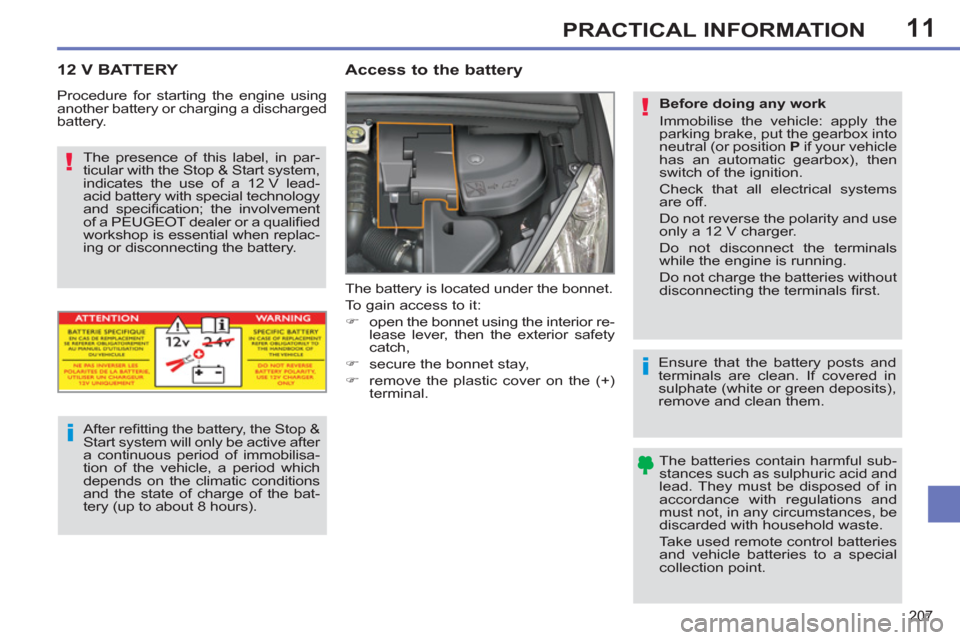
11
207
PRACTICAL INFORMATION
12 V BATTERY
Access to the battery
The battery is located under the bonnet.
To gain access to it:
�)
open the bonnet using the interior re-
lease lever, then the exterior safety
catch,
�)
secure the bonnet stay,
�)
remove the plastic cover on the (+)
terminal.
The presence of this label, in par-
ticular with the Stop & Start system,
indicates the use of a 12 V lead-
acid battery with special technology
and specifi cation; the involvement
of a PEUGEOT dealer or a qualifi ed
workshop is essential when replac-
ing or disconnecting the battery.
After refi tting the battery, the Stop &
Start system will only be active after
a continuous period of immobilisa-
tion of the vehicle, a period which
depends on the climatic conditions
and the state of charge of the bat-
tery (up to about 8 hours).
Procedure for starting the engine using
another battery or charging a discharged
battery.
Before doing any work
Immobilise the vehicle: apply the
parking brake, put the gearbox into
neutral (or position P
if your vehicle
has an automatic gearbox), then
switch of the ignition.
Check that all electrical systems
are off.
Do not reverse the polarity and use
only a 12 V charger.
Do not disconnect the terminals
while the engine is running.
Do not charge the batteries without
disconnecting the terminals fi rst.
Ensure that the battery posts and
terminals are clean. If covered in
sulphate (white or green deposits),
remove and clean them.
The batteries contain harmful sub-
stances such as sulphuric acid and
lead. They must be disposed of in
accordance with regulations and
must not, in any circumstances, be
discarded with household waste.
Take used remote control batteries
and vehicle batteries to a special
collection point.